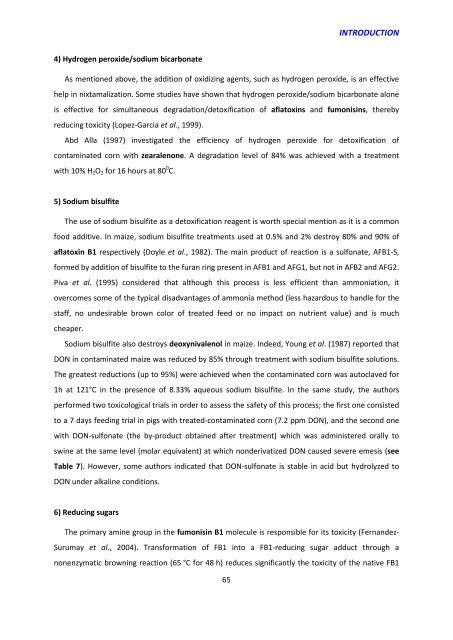Effet chez le porcelet d'une exposition à un régime co-contaminé en ...
Effet chez le porcelet d'une exposition à un régime co-contaminé en ...
Effet chez le porcelet d'une exposition à un régime co-contaminé en ...
You also want an ePaper? Increase the reach of your titles
YUMPU automatically turns print PDFs into web optimized ePapers that Google loves.
INTRODUCTION4) Hydrog<strong>en</strong> peroxide/sodium bicarbonateAs m<strong>en</strong>tioned above, the addition of oxidizing ag<strong>en</strong>ts, such as hydrog<strong>en</strong> peroxide, is an effectivehelp in nixtamalization. Some studies have shown that hydrog<strong>en</strong> peroxide/sodium bicarbonate aloneis effective for simultaneous degradation/detoxification of aflatoxins and fumonisins, therebyreducing toxicity (Lopez-Garcia et al., 1999).Abd Alla (1997) investigated the effici<strong>en</strong>cy of hydrog<strong>en</strong> peroxide for detoxification of<strong>co</strong>ntaminated <strong>co</strong>rn with zeara<strong>le</strong>none. A degradation <strong>le</strong>vel of 84% was achieved with a treatm<strong>en</strong>twith 10% H 2 O 2 for 16 hours at 80 0 C.5) Sodium bisulfiteThe use of sodium bisulfite as a detoxification reag<strong>en</strong>t is worth special m<strong>en</strong>tion as it is a <strong>co</strong>mmonfood additive. In maize, sodium bisulfite treatm<strong>en</strong>ts used at 0.5% and 2% destroy 80% and 90% ofaflatoxin B1 respectively (Doy<strong>le</strong> et al., 1982). The main product of reaction is a sulfonate, AFB1-S,formed by addition of bisulfite to the furan ring pres<strong>en</strong>t in AFB1 and AFG1, but not in AFB2 and AFG2.Piva et al. (1995) <strong>co</strong>nsidered that although this process is <strong>le</strong>ss effici<strong>en</strong>t than ammoniation, itover<strong>co</strong>mes some of the typical disadvantages of ammonia method (<strong>le</strong>ss hazardous to hand<strong>le</strong> for thestaff, no <strong>un</strong>desirab<strong>le</strong> brown <strong>co</strong>lor of treated feed or no impact on nutri<strong>en</strong>t value) and is muchcheaper.Sodium bisulfite also destroys deoxyniva<strong>le</strong>nol in maize. Indeed, Yo<strong>un</strong>g et al. (1987) reported thatDON in <strong>co</strong>ntaminated maize was reduced by 85% through treatm<strong>en</strong>t with sodium bisulfite solutions.The greatest reductions (up to 95%) were achieved wh<strong>en</strong> the <strong>co</strong>ntaminated <strong>co</strong>rn was autoclaved for1h at 121°C in the pres<strong>en</strong>ce of 8.33% aqueous sodium bisulfite. In the same study, the authorsperformed two toxi<strong>co</strong>logical trials in order to assess the safety of this process; the first one <strong>co</strong>nsistedto a 7 days feeding trial in pigs with treated-<strong>co</strong>ntaminated <strong>co</strong>rn (7.2 ppm DON), and the se<strong>co</strong>nd onewith DON-sulfonate (the by-product obtained after treatm<strong>en</strong>t) which was administered orally toswine at the same <strong>le</strong>vel (molar equiva<strong>le</strong>nt) at which nonderivatized DON caused severe emesis (seeTab<strong>le</strong> 7). However, some authors indicated that DON-sulfonate is stab<strong>le</strong> in acid but hydrolyzed toDON <strong>un</strong>der alkaline <strong>co</strong>nditions.6) Reducing sugarsThe primary amine group in the fumonisin B1 mo<strong>le</strong>cu<strong>le</strong> is responsib<strong>le</strong> for its toxicity (Fernandez-Surumay et al., 2004). Transformation of FB1 into a FB1-reducing sugar adduct through anon<strong>en</strong>zymatic browning reaction (65 °C for 48 h) reduces significantly the toxicity of the native FB165

















